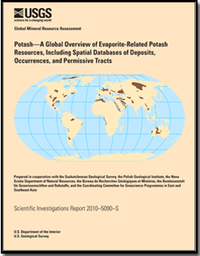Potash: a global overview of evaporate-related potash resources, including spatial databases of deposits, occurrences, and permissive tracts
Links
- More information: USGS Index Page
- Document: Report (7.9 MB pdf)
- Larger Work: This publication is Chapter S of Global mineral resource assessment
- Databases:
- GIS Package (75 MB) Contains: geospatial database in Arc GIS format
- GIS Package (6 MB) Contains: geospatial database in KML format.
- GIS Package (600 kB) Contains: database in Excel format.
- Read Me: Read Me (16 kB)
- Download citation as: RIS | Dublin Core
Abstract
Potash is mined worldwide to provide potassium, an essential nutrient for food crops. Evaporite-hosted potash deposits are the largest source of salts that contain potassium in water-soluble form, including potassium chloride, potassium-magnesium chloride, potassium sulfate, and potassium nitrate. Thick sections of evaporitic salt that form laterally continuous strata in sedimentary evaporite basins are the most common host for stratabound and halokinetic potash-bearing salt deposits. Potash-bearing basins may host tens of millions to more than 100 billion metric tons of potassium oxide (K2O). Examples of these deposits include those in the Elk Point Basin in Canada, the Pripyat Basin in Belarus, the Solikamsk Basin in Russia, and the Zechstein Basin in Germany.
This report describes a global, evaporite-related potash deposits and occurrences database and a potash tracts database. Chapter 1 summarizes potash resource history and use. Chapter 2 describes a global potash deposits and occurrences database, which contains more than 900 site records. Chapter 3 describes a potash tracts database, which contains 84 tracts with geology permissive for the presence of evaporite-hosted potash resources, including areas with active evaporite-related potash production, areas with known mineralization that has not been quantified or exploited, and areas with potential for undiscovered potash resources. Chapter 4 describes geographic information system (GIS) data files that include (1) potash deposits and occurrences data, (2) potash tract data, (3) reference databases for potash deposit and tract data, and (4) representative graphics of geologic features related to potash tracts and deposits. Summary descriptive models for stratabound potash-bearing salt and halokinetic potash-bearing salt are included in appendixes A and B, respectively. A glossary of salt- and potash-related terms is contained in appendix C and a list of database abbreviations is given in appendix D. Appendix E describes GIS data files, and appendix F is a guide to using the geodatabase.
| Publication type | Report |
|---|---|
| Publication Subtype | USGS Numbered Series |
| Title | Potash: a global overview of evaporate-related potash resources, including spatial databases of deposits, occurrences, and permissive tracts |
| Series title | Scientific Investigations Report |
| Series number | 2010-5090 |
| Chapter | S |
| DOI | 10.3133/sir20105090S |
| Year Published | 2014 |
| Language | English |
| Publisher | U.S. Geological Survey |
| Publisher location | Reston, VA |
| Contributing office(s) | Eastern Mineral and Environmental Resources Science Center, Geology, Minerals, Energy, and Geophysics Science Center |
| Description | Report: vi, 76 p.; Readme; 3 GIS Packages |
| Larger Work Type | Report |
| Larger Work Subtype | USGS Numbered Series |
| Larger Work Title | Global mineral resource assessment |
| Public Comments | This report is Chapter S in Global mineral resource assessment. For more information, see: Scientific Investigations Report 2010-5090. |
| Online Only (Y/N) | N |
| Additional Online Files (Y/N) | N |


